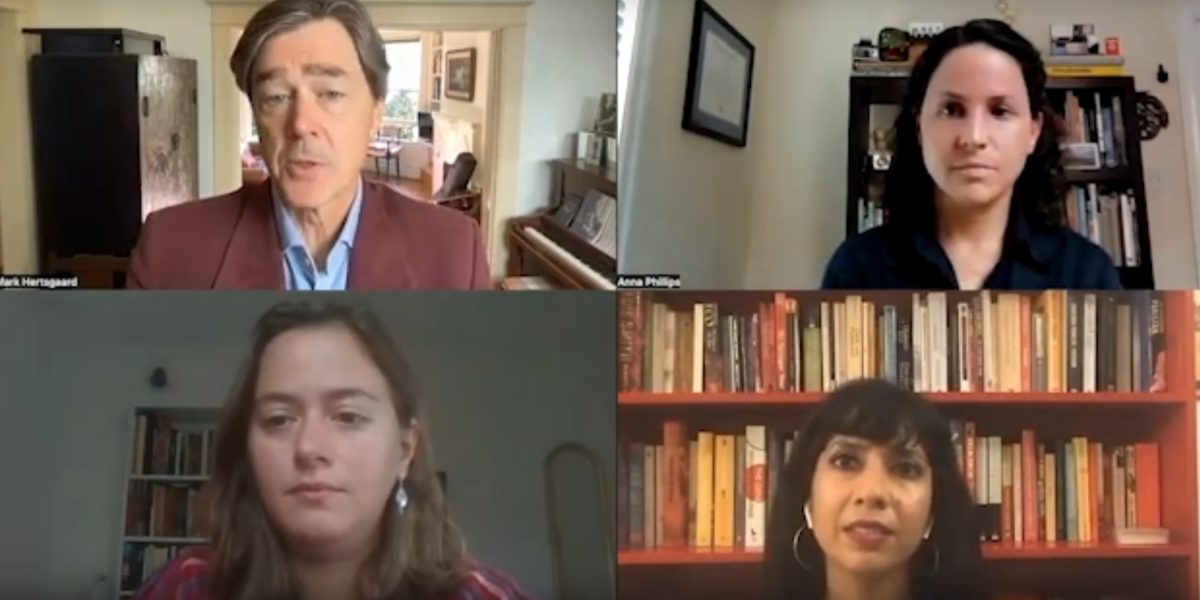A recent virtual panel focused on covering the human impact of extreme heat events sought to provide a blueprint for reporters to approach their climate journalism.
The event was organized by Covering Climate Now (CCNow), an organization by journalists for journalists that hopes to equip reporters with the tools, resources and best practices when it comes to reporting on extreme weather events and the greater climate crisis.
Open to journalists from anywhere around the world, the speakers included independent journalists Sofia Moutinho and Snigda Poonam. It was moderated by CCNow’s executive director, Mark Hertsgaard, who also works as an environmental correspondent for The Nation magazine.
As Hertsgaard says, record-breaking heat and extreme weather events have “brutalized” many parts of the world, with the past few months being no exception.
But as the globe grapples with the increasing frequency of extreme weather events, Hertsgaard noted that scientists have made significant progress in understanding the oppressive heat.
“They can now calculate how much responsibility global warming has for these high temperatures and how many people are dying from them,” Hertsgaard explained, noting that India’s spring heatwave was made 30 times more likely by global climate change.
And while there’s been a big focus on the heat, Hertsgaard warns that warm temperatures are one of many extreme weather events that will cause damage, disruption, and ultimately, displacement in many parts of the world.
Bringing the human element to climate crisis coverage
While Poonam doesn’t consider her beat to be climate-focused, she recently penned a powerful feature for the MIT Technology Review that looked at how locals in a village known as Nagla Tulai are struggling to beat the heat with no access to air conditioning, fans, or even electricity.
Poonam explained that the climate crisis is becoming an increasingly focal part of storytelling—whether through election coverage, violence, crime or gender.
“I find that the kind of people that I am talking to, who happen to be often on the margins, are also going through a crisis that is made worse by climate change,” Poonam said.
Poonam’s story about surviving without electricity in 110 degrees was difficult to write, but she says, was even harder to bear.
“As soon as I got out of my car, I wasn’t able to see anything in front of me because the sweat just would pour down my face and was getting into my eyes,” she said, adding that the heat left her speechless, short of breath, and on the verge of fainting.
But the scariest part for Poonam was that many of the locals did not connect the oppressive heat to the climate crisis.
“I think that they just believe that the heat is getting rapidly worse with every year, but they don’t think it is climate change,” she said, noting that misinformation is rampant, particularly on the social media platform WhatsApp.
But what Poonam remembers most is the heat inside the homes of the community, where women make rotis—an Indian flatbread—by rolling out dough before cooking it on a hot stove above a wood fire.
“I couldn’t even bear to stand there for very long because it was getting so hard, but they have to make rotis every time any one in the family is hungry,” she explained.
The correlation between low-income communities and heat-related illnesses
Sofia Moutinho relies on data to tell human stories. Working alongside the Columbia School of Journalism in New York, Moutinho analyzed federal patient-level data from the Healthcare Cost and Utilization Project
“We basically had everything about everyone who went to an emergency room, or got hospitalized in both Florida and Arizona,” she said, noting it was a “huge volume of data.”
As part of a series called Hidden Epidemics, Moutinho and her colleagues knew from the beginning that they wanted to write about extreme heat. The final product, Dangerous Heat, Unequal Consequences, won an award from the Association of Health Care Journalists.
“We saw a lot of cases of old men walking the streets in the scorching sun. They would get dizzy and pass out, hit the ground and bump their head, and sometimes even burn the skin because the asphalt was too hot.”
Initially, Moutinho noted that she couldn’t find a commonality between the communities with the highest rates of heat-related illness. But when her colleague suggested correlating heat-related illnesses and income brackets, they struck gold.
“This is not by chance that these places are bearing the brunt,” she explained. “People there don’t have enough money to pay electricity bills to have air conditioning, they don’t have good access to health care… there are many factors that, ultimately, I linked to systemic poverty and systemic racial segregation.”
Ultimately, Hertsgaard says, there are three main factors journalists should consider for effective climate storytelling: humanize, localize, and solutionize:
“Talk about human beings, not just abstract science. Second, locate that human story in a place that your audience knows and cares about. And third, don’t forget about solutions. Of course, we report the problems. But don’t stop there. Tell the whole story, the problem and potential ways to fix it.”
This article is part of rabble’s series “The Boiling Point.” The Boiling Point examines the ways increasingly high temperatures due to the climate crisis are affecting our summers in Canada on a social, institutional, and ecological level. The series also explains how Canadians can take action against climate change and make real differences in their communities. Follow more stories here.



